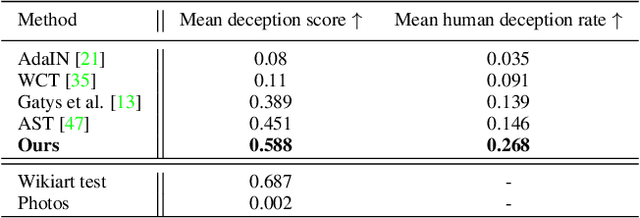Matthias Wright
ArtFID: Quantitative Evaluation of Neural Style Transfer
Jul 25, 2022



Abstract:The field of neural style transfer has experienced a surge of research exploring different avenues ranging from optimization-based approaches and feed-forward models to meta-learning methods. The developed techniques have not just progressed the field of style transfer, but also led to breakthroughs in other areas of computer vision, such as all of visual synthesis. However, whereas quantitative evaluation and benchmarking have become pillars of computer vision research, the reproducible, quantitative assessment of style transfer models is still lacking. Even in comparison to other fields of visual synthesis, where widely used metrics exist, the quantitative evaluation of style transfer is still lagging behind. To support the automatic comparison of different style transfer approaches and to study their respective strengths and weaknesses, the field would greatly benefit from a quantitative measurement of stylization performance. Therefore, we propose a method to complement the currently mostly qualitative evaluation schemes. We provide extensive evaluations and a large-scale user study to show that the proposed metric strongly coincides with human judgment.
Rethinking Style Transfer: From Pixels to Parameterized Brushstrokes
Mar 31, 2021



Abstract:There have been many successful implementations of neural style transfer in recent years. In most of these works, the stylization process is confined to the pixel domain. However, we argue that this representation is unnatural because paintings usually consist of brushstrokes rather than pixels. We propose a method to stylize images by optimizing parameterized brushstrokes instead of pixels and further introduce a simple differentiable rendering mechanism. Our approach significantly improves visual quality and enables additional control over the stylization process such as controlling the flow of brushstrokes through user input. We provide qualitative and quantitative evaluations that show the efficacy of the proposed parameterized representation.
 Add to Chrome
Add to Chrome Add to Firefox
Add to Firefox Add to Edge
Add to Edge